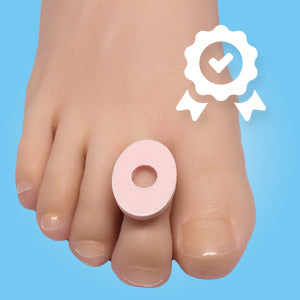Do You Know the Difference Between a Corn and a Callus?
People often mistake corns and calluses as being the same thing. Although they are similar, they are not the same. In today’s blog we’re going to explore the difference between the two and what you can do about them.
What is a Corn?
A corn is similar to a callus in that it is made up of dead skin. They typically form on hairless, smooth surfaces and often appear on the side or top of the toes. They are circular shaped and small with a clearly defined center that may be either soft or hard.
Hard corns usually form where skin is hard or thickened, such as in areas where there are calluses, or bony areas of the foot. They also tend to be smaller than soft corns. Soft corns have a rubbery texture and are usually whitish in color. They often appear in areas where skin is sweaty and moist, such as between the toes.
Corns are the result of repeated pressure on the skin and people with other foot deformities, such as hammertoes, are more likely to suffer from corns because their feet rub in certain places in their shoes more than others. Corns are often painful when being pressed on.
What is a Callus?
A callus is an area of skin that becomes thickened due to repeated rubbing and pressure. They may vary in size and some may become painful. They occur when the skin is trying to protect an underlying area from rubbing, pressure, or injury.
Calluses are typically pale or yellowish in color and they may feel lumpy when touched. They are often less sensitive than the areas of skin around them. Calluses are usually bigger than corns and don’t have the defined edges like a corn has.
They typically form over the bony areas just under the toes or other areas of skin that take the brunt of a person’s weight when they walk.
Symptoms of Calluses and Corns
Although calluses and corns are not the same, they present with many of the same symptoms. They may make a person feel like they are walking on a stone, or have something hard in their shoe. Other symptoms may include:
- A hardened, raised bump on the foot
- A rough or thick area of skin
- Skin that has become flaky, dry, or waxy
- Tenderness or pain under the skin in one specific area
Fortunately, there are many options for treatment if a corn or callus becomes painful and inflamed. People who have fragile skin, poor circulation, or numbness or nerve problems in their feet should discuss treatment options with a doctor before trying to treat calluses and corns at home. People with peripheral neuropathy, diabetes, or peripheral artery disease need to be especially cautious.
Risk Factors and Causes
Although a corn or callus can appear on anyone certain risk factors make people more likely to suffer from either of the conditions:
- Friction or pressure on the skin such as shoes that are high heeled, too tight, or too loose
- Socks that do not fit well and wearing no socks
- Regularly walking bare foot
- Repeatedly walking or jogging in a particular way
- Old age because your feet have less padding
- Deformities of the foot including bunions and hammertoes
Prevention of Corns and Calluses
There are certain measures that can be taken to reduce your risk of developing a corn or callus. These include:
- Wash your feet nightly with soap and water
- Thoroughly dry your feet after washing and apply foot cream. Do not use regular body lotion.
- Wear well-fitting socks and shoes that don’t rub on the skin.
- When shopping for shoes shop later in the day because feet swell a bit as the day progresses
- Take care of skin irritation and foot pain as soon as it arises
- Schedule regular foot checkups with a foot specialist
- Trim your toenails straight across
- Use a foot file regularly to gently remove hard skin
- Wear clean socks every day
Treating Corns and Calluses
Many corns and calluses can be treated at home using over the counter products. Treatment options may include:
- Soak your foot in warm water for five to ten minutes then file or scrape the area with a pumice stone.
- Avoid repetitive actions if they are the cause of your condition.
- Use lotion that contains urea, salicylic acid, or ammonium lactate every day. This can also soften any dry skin so it can be filed easier.
- Wear shoes and socks that fit properly.
- Use silicone separators between the toes to reduce pressure on the corn.
- Wear pads or cushions that are designed to relieve pressure due to calluses.
If you are having significant pain or you have fragile skin, diabetes, or circulatory issues, be sure to consult with a podiatrist or doctor who can advise you what treatments are good options for you.
A doctor or foot specialist may decide to cut away some of the thickened skin to relieve the pressure to the underlying tissue. However, you should never try to cut your corn or callus yourself at home because the risk of infection is high.


